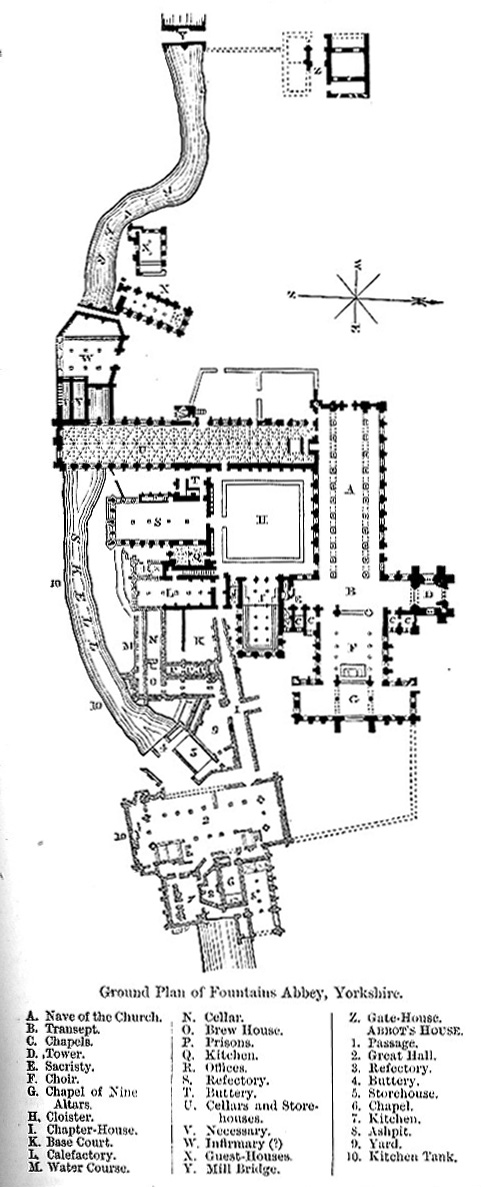(C) Cistercian Abbeys (cont.)
Fountains Abbey, Yorkshire
Fountains Abbey, first founded A.D. 1132, deserves special notice, as one of the largest and best preserved Cistercian houses in England. But the earlier buildings received considerable additions and alterations in the later period of the order, causing deviations from the strict Cistercian type.
The church stands a short distance to the north of the river Skell, the buildings of the abbey stretching down to and even across the stream. We have the cloister (H) to the south, with the three-aisled chapter-house (I) and calefactory (L) opening from its eastern walk, and the refectory (S), with the kitchen (Q) and buttery (T) attached, at right angles to its southern walk. Parallel with the western walk is an immense vaulted substructure (U), incorrectly styled the cloisters, serving as cellars and store-rooms, and supporting the dormitory of the conversi above. This building extended across the river. At its S.W. corner were the necessaries (V), also built, as usual above the swiftly flowing stream. The monks' dormitory was in its usual position above the chapter-house, to the south of the transept. As peculiarities of arrangement may be noticed the position of the kitchen (Q), between the refectory and calefactory, and of the infirmary (W) (unless there is some error in its designation) above the river to the west, adjoining the guest-houses (XX). We may also call attention to the greatly lengthened choir, commenced by Abbot John of York, 1203-1211, and carried on by his successor, terminating, like Durham Cathedral, in an eastern transept, the work of Abbot John of Kent, 1220- 1247, and to the tower (D), added not long before the dissolution by Abbot Huby, 1494-1526, in a very unusual position at the northern end of the north transept. The abbot's house, the largest and most remarkable example of this class of buildings in the kingdom, stands south to the east of the church and cloister, from which it is divided by the kitchen court (K), surrounded by the ordinary domestic offices. A considerable portion of this house was erected on arches over the Skell. The size and character of this house, probably, at the time of its erection, the most spacious house of a subject in the kingdom, not a castle, bespeaks the wide departure of the Cistercian order from the stern simplicity of the original foundation. The hall (2) was one of the most spacious and magnificent apartments in mediaeval times, measuring 170 feet by 70 feet. Like the hall in the castle at Winchester, and Westminster Hall, as originally built, it was divided by 18 pillars and arches, with 3 aisles. Among other apartments, for the designation of which we must refer to the ground-plan, was a domestic oratory or chapel, 46 ¸ feet by 23 feet, and a kitchen (7), 50 feet by 38 feet. The whole arrangements and character of the building bespeak the rich and powerful feudal lord, not the humble father of a body of hardworking brethren, bound by vows to a life of poverty and self-denying toil. In the words of Dean Milman, "the superior, once a man bowed to the earth with humility, care-worm, pale, emaciated, with a coarse habit bound with a cord, with naked feet, had become an abbot on his curvetting palfrey, in rich attire, with his silver cross before him, traveling to take his place amid the lordliest of the relam." -- (Lat. Christ, vol. iii. p. 330).
Read the rest of this article:
Abbey - Table of Contents
